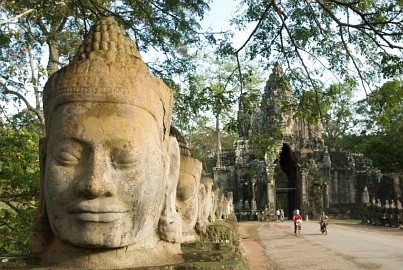
Even excluding the over 100 temples in the Angkor Wat complex, there is a great deal to see and do in and around the town. Visits to other religious monuments, markets, Tonle Sap Lake with its floating villages, the Angkor National Museum, the Cultural Village, bird-watching, yoga and cooking classes, environmental tours, countryside tours and much more make Siem Reap a tourist paradise.
There are more than 100 temples inside the moat at the Angkor Wat complex, all with exquisite carvings, but to make the most of a visit to Siem Reap, the one must-see after Angkor Wat itself is the Bayon in the royal city of Angkor Thom, a kilometer from the temple complex.
This mysterious treasure of Cambodian Buddhism, with its 216 huge and haunting faces carved in high relief all over the massive structure, was built during the reign of the great god-king Jayarbarman VII as the state temple of the Khmer Empire.
In the north of the town is the Royal Palace with its famous Silver Pagoda, set in beautiful gardens. The palace's Throne Hall is a masterpiece of the elaborate and spectacular Cambodian decorative arts.
The recently-opened Angkor National Museum on the road to Angkor Wat is divided into eight galleries, with Angkorean history and culture represented chronologically both by the artifacts displayed and by multi-media presentations. Many of the exhibits have been borrowed from the National Museum in Phnom Penh.
Siem Reap contains a large number of temples, pagodas and shrines. The 18th century Wat Bo's pagoda is highly respected by local Buddhists, as is the small shrine in front of the Grand Hotel d'Angkor. This shrine contains two Buddha statues, legendarily of great power and indestructibility and much revered by local pilgrims.
For a complete contrast, visitors to the Siem Reap War Museum on Airport Road 6 can see missiles, land mines, tanks, helicopters and weapons used in the conflict between the Khmer Rouge and the anti-communists forces which tore Cambodia apart from 1967 to 1975, leading to the Cambodian genocide.
The scenic Tonle Sap Lake, the largest freshwater lake in Southeast Asia, is fed through a unique system by the Mekong River. During the rainy season, the lake increases dramatically in size, irrigating its surrounding agricultural floodplain. Local communities live by the lakeside and on the lake in floating villages.
The floating village on Tonle Sap Lake makes for an interesting boat trip. Villagers' entire lives are spent on the water in homes built on floating platforms, with regular visits from floating shops and a clinic. Kids go to the floating school while tourism provides revenue for their parents.
Constructed of pink sandstone, the 10th century temple of Banteay Srei (Citadel of the Women), located 30kms northeast of Angkor Wat, is covered in uniquely detailed and intricate surface carvings, supposedly done by women artisans.
Perched on a hill overlooking Angkor Wat is the temple of Phom Bakheng, famous for its sunrises and sunsets. It's a slow, easy climb by the southern trail although experienced hikers can use the frontal trail and arrive within 10 minutes. As the sun rises over the monuments, the shadows cast by the sacred stones are breathtaking.